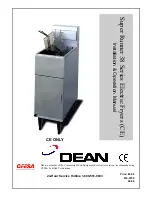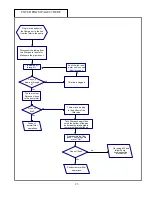
8
3.5 INITIAL START-UP:
a.
CLEANING: New units are wiped
clean with solvents at the factory to
remove any visible signs of dirt, oil,
grease, etc. remaining from the
manufacturing process, then coated
lightly with oil. Wash thoroughly with
hot, soapy water to remove any film
residue and dust or debris before food
preparation, then rinse out and wipe
dry. Wash also any accessories
shipped with the unit. Close the drain
valve completely and remove the
crumb screen. Make sure the screws
holding the thermostat and limit
control sensing bulbs into the vessel
are tight.
b.
HEATING THE VESSEL: This step
checks heater element operation, initial
thermostat calibration, and cleans the
vessel for initial food production.
1.
Fill the fryer vessel with hot or
cold water to the oil level line
scribed in the back of the tank.
2.
Set the thermostat/temperature
controller dial to 100°C/220°F, just
above that of boiling water.
3.
Toggle the power switch “ON”. The
heater elements will begin heating.
4.
When the water starts to boil, turn
the dial to below 99°C/210°F.
The elements will turn off and the
water will stop boiling.
5.
When satisfied that the heaters
and thermostat operate properly,
drain the vessel of water and dry
thoroughly. Refill fry vessel with
shortening as directed in section
3.6, Final Preparation.
3.6 FINAL PREPARATION:
a.
When using liquid shortening
(cooking oil), fill the fryer to the “oil
level” line scribed into the back of the
fryer vessel.
b.
When using solid shortening, either
melt it first, or cut into small pieces
and pack into cool zone (bottom) of
the frying vessel. Be careful to not
leave any air spaces or disturb the
sensing bulbs. Melt shortening by
turning the heaters “ON” for about
five or ten seconds, “OFF” for a
minute, repeating cycle until
shortening is melted. If oil starts to
smoke while melting this way,
shorten the “ON” cycle and lengthen
the “OFF” cycle. Smoke shows that
you are scorching the shortening and
cutting its useful life.
NOTE:
Never melt a solid block of shortening
by setting it in the vessel or on top of the
heating elements. This is unsafe, inefficient,
and dangerous.
c.
When the fryer vessel is filled and the
shortening melted, replace the crumb
screen over the heater elements.
d.
Before starting operation, turn the
temperature controller to the probable
working temperature; wait for the
temperature to stabilize then check
with a high-quality immersion
thermometer.
Figure 3-3
Power Switch
Temperature Controller










































